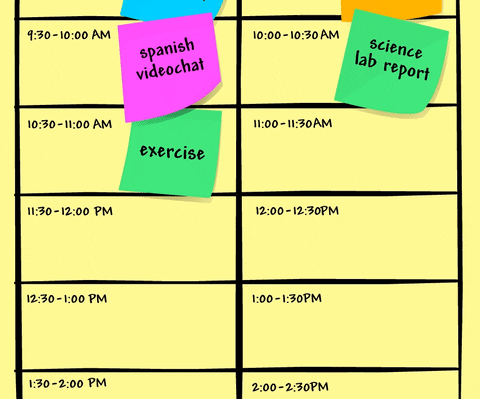Avoid procrastination
We all have our version of horror stories related to studying. Whether cramming at the last minute or forgetting the information during the exam, our study experiences have been dreadful sometimes. But it doesn’t have to remain that way.
Having a study schedule is one way to overcome these difficulties. Not only is it helpful to stay organized, but you’re one step closer to acing your exams!
Don’t know where to start? Not to worry, here are six ways to create a study schedule that really works for you.
Set realistic goals

“What are your goals for the semester?”
Setting goals will make creating the perfect study schedule more manageable. For example, are you trying to keep up with all your coursework? Or are you working towards a high GPA? Establishing your goals will help you to identify the tasks and resources needed to achieve your objective.
Most importantly, it will help you to determine how much time you can allot to accomplish these goals.
Evaluate your learning style and study habits

Who knows? Maybe you like reading textbooks.
Knowing your learning style helps you find study techniques that work for you! Once that’s determined, take the time to evaluate your study habits and make adjustments if necessary. For example, do you prefer to study at night? Or do you lose focus after long periods?
Once you are aware of your learning style, tailor your study sessions to suit you.
Analyze your study schedule

With personal commitments, classes, and work, you might think you don’t have enough time to study. But guess what? You do. You just need to manage your time wisely.
To create your schedule, ensure all your classes, work, and other commitments are blocked out in your calendar. If your schedule still looks jam-packed, you might need to scale back on some activities.
And now, you can see a clear picture of your available study time.
Determine what you should do for each course

It’s time to evaluate your courses and the exam format. For example, do you need to watch all those tutorials? Or do you need to read those research articles? Identifying the resources required for each course will help determine how much time you should allocate to studying.
Divide available time into study blocks

Here comes the tricky part, creating study blocks for each course. For example, you might be available between 2 – 4 p.m. every Wednesday. This would be the perfect time to schedule a study session.
It’s recommended to schedule study sessions in 30 to 45 minute blocks. Once you have done so, it’s time to allocate these blocks to each of your courses.
Schedule study breaks

Taking breaks is essential!
Studying without breaks is a disaster waiting to happen. So after each study session, it’s essential to take a break to refresh yourself. Also, not only does it help us to relax, but it improves our memory skills too!
But be mindful of taking too many breaks. You don’t want to end up binge-watching your favourite Netflix series.
You now have all the knowledge to create the perfect study schedule. Remember it’s your responsibility to follow your schedule. And guess what? Now, you won’t have to stress about being behind on your studies because your study schedule is here to support you!
Are you struggling to keep up this semester? Here are tips for managing in-person classes.
Follow IGNITE on Facebook, Instagram, and Twitter for all things student life.
